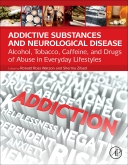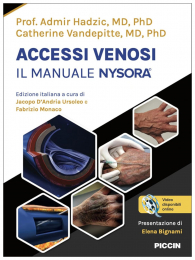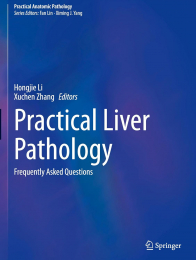Non ci sono recensioni
DA SCONTARE
Features:
- Integrates current research on the actions of addictive substances in neurological disease
- Includes functional foods, such as caffeine beverages, that have habituating effects on the brain
- Provides a synopsis of key ideas associated with the consequences of addictive and habituating lifestyle substances
Part I. Alcohol and Neurological Dysfunction
Chapter 1. Acute Ethanol-Induced Changes in Microstructural and Metabolite Concentrations on the Brain: Noninvasive Functional Brain Imaging
- Introduction
- Conclusion
Chapter 2. Prenatal Alcohol Exposure and Neuroglial Changes in Neurochemistry and Behavior in Animal Models
- Ethanol Exposure and Brain Development
- Ethanol, Glia, and Neurodevelopment
- Cognitive and Behavioral Effects of Pre- and Postnatal Ethanol Exposure
Chapter 3. Alcohol on Histaminergic Neurons of Brain
- Introduction
- The Effects of Alcohol on Histamine Levels in the Brain
- Brain Histaminergic System in Human Alcoholics
- The Role of H3 Receptors in Modulation of Alcohol Stimulation and Reward
- Histological Changes in Histaminergic Neurons Following Alcohol Administration
- Histochemical Changes in Histaminergic Neurons Following Alcohol Administration
- Alcohol Effects Into a Histaminergic Neurons Ultrastructure
Chapter 4. Antenatal Alcohol and Histological Brain Disturbances
- Introduction
- Neurohistology
- Cellular and Molecular Disorders
- Possible Mechanisms for the Development of Behavioral and Mental Disorders After Prenatal Alcohol Exposure
Chapter 5. Alcohol Intoxication and Traumatic Spinal Cord Injury: Basic and Clinical Science
- Introduction
- Pathophysiology of Traumatic Spinal Cord Injury
- Vascular Injury
- Membrane Dysfunction and Edema Formation
- Inflammation and Immune-Mediated Response to Spinal Cord Injury
- Free Radical Formation and Lipid Peroxidation
- Excitatory Neurotransmitters
- Alcohol Intoxication and the Effects on Preclinical Spinal Cord Injury
- Alcohol and Functional Outcomes
- Alcohol Intoxication and Injury Severity
- Alcohol Use and Spinal Cord Injury Patients
- Conclusion
Chapter 6. Visual and Auditory Changes After Acute Alcohol Ingestion
- Introduction
- Characterization of Acute Use of Alcohol
- Alcohol and Visual Perception
- Alcohol and Auditory Perception
- Research Carried Out by the Laboratory of Research in Perception, Neuroscience, and Behavior—LPNeC
- Alcohol in Neural Systems of Vision and Hearing
Chapter 7. Zebrafish Models of Alcohol Addiction
- Alcohol Addiction in Humans
- Animal Models of Alcohol Addiction
- Zebrafish as an Animal Model for Behavioral Neuroscience
- Zebrafish as an Animal Model for Alcohol Addiction
- Alcohol-Induced Locomotor Activity
- Alcohol-Induced Anxiolysis
- Alcohol-Induced Tolerance
- Alcohol-Induced Sensitization
- Alcohol-Induced Withdrawal
- Alcohol-Induced Conditioned Place Preference
- Voluntary Alcohol Consumption
- Limitations of the Zebrafish Model
Chapter 8. Effect of Alcohol on the Regulation of a-Synuclein in the Human Brain
- Overview
- a-Synuclein Function
- Conclusion
Chapter 9. Consumption of Ethanol and Tissue Changes in the Central Nervous System
- Introduction
- Neuronal and Glial Changes
- Modulations in Cell Proliferation and Neurogenesis
- Most Significant Regional Alterations
Chapter 10. Ethanol Consumption and Cerebellar Disorders
- Introduction
- Cerebellum: An Anatomo-physiological Review
- EtOH Effects on the Cerebellum Neurophysiology
- Functional and Cellular Changes From Ingesting EtOH
- Clinical Changes Resulting From Ingestion of EtOH
Chapter 11. Gene Expression in CNS Regions of Genetic Rat Models of Alcohol Abuse
- Introduction
- Selectively Bred High and Low Ethanol-Consuming Lines of Rats
- Innate Differences in Gene Expression in the VTA, Acb-Shell, and CeA Between HEC and LEC Rats
- Multiple Interacting Factors Can Impact the Effects of Alcohol Drinking on Gene Expression in the CNS
- The P Rat as an Animal Model for Studying Alcohol Drinking–Induced Changes in Gene Expression
- Gene Expression Changes in the Acb Following 24-h Free-Choice Alcohol Drinking: Effects of Withdrawal
- Gene Expression Changes in the Acb During Operant Scheduled Access Alcohol Drinking
- Changes in Gene Expression in the Acb-Shell and CeA Following Daily Multiple Alcohol Binge Drinking Episodes
- Changes in Gene Expression in the VTA Following Daily Multiple Excessive Alcohol Binge–Drinking Episodes
- Conclusions
Chapter 12. Role of TLR4 in the Ethanol-Induced Modulation of the Autophagy Pathway in the Brain
- Autophagy as a Physiological Self-degradative Process
- Ethanol Effects on the Autophagy Pathway
- The TLR4 Immune Response
- Conclusions and Future Directions
Chapter 13. Ghrelinergic Signaling in Ethanol Reward
- Introduction: Ghrelin Physiology
- Energy Metabolism and Homeostasis
- Limbic System Signaling
- Mesolimbic Reward Pathway
- Ethanol and Drug Reward
- Conclusion
Chapter 14. Alcoholic Neurological Syndromes
- Introduction
- Fetal Alcohol Syndrome
- Pharmacokinetic Mechanisms of Alcohol Teratogeny
- Teratogenic Effects of Alcohol on the CNS
- Clinical Diagnosis of Fetal Alcohol Spectrum Disorders
- Central Pontine and Extrapontine Myelinolysis
- Marchiafava–Bignami Disease
- Wernicke–Korsakoff Syndrome
- Final Comments
Chapter 15. Frontal Lobe Dysfunction After Developmental Alcohol Exposure: Implications From Animal Models
- Introduction
- FASDs in Humans
- Animal Models of FASDs
- Conclusion
Chapter 16. Ethanol's Action Mechanisms in the Brain: From Lipid General Alterations to Specific Protein Receptor Binding
- Introduction
- Ethanol Actions on Lipid Membrane
- Protein Targets Related to Ethanol Effects
- Conclusions
Chapter 17. Antioxidant Vitamins and Brain Dysfunction in Alcoholics
- Introduction
- Vitamin E Deficiency
- Vitamin A Deficiency
- Vitamin D Deficiency
- Vitamin B12, B6, and Folate Alterations: Hyperhomocysteinemia
- Thiamine Deficiency and Wernicke Encephalopathy
- Vitamin C Deficiency
- Conclusions and Future Prospects
Chapter 18. Serotonin Deficiency and Alcohol Use Disorders
- Introduction
- Alcohol Typologies
- 5-HT Depletion Studies
- 5-HT Dysfunction and Alcohol Consumption
- 5-HT Deficiency, Impulsivity, and Aggression
- 5-HT Deficiency and AUD Treatment Responses
- Concluding Remarks
- Glossary
Part II. Addictive Substances and Behavioral Health
Chapter 19. Functional Reorganization of Reward- and Habit-Related Brain Networks in Addiction
- Introduction
- Functional Reorganization Processes in Brain Circuits of Reward and Motivation
- Functional Reorganization Processes in Brain Circuits of Habits and Automaticity
- Conclusion
Chapter 20. Ethanol: Neurotoxicity and Brain Disorders
- Introduction
- Alcohol Chemistry and Kinetics
- Mechanisms of Neurotoxicity
- CNS Structural Changes and Behavioral Effects
- Perspectives and Final Comments
Chapter 21. Functionally Relevant Brain Alterations in Polysubstance Users: Differences to Monosubstance Users, Study Challenges, and Implications for Treatment
- Introduction
- Prevalence of PSU
- Overview of Cognition in Monosubstance Users
- Overview of Neuroimaging in Monosubstance Users
- Review of Cognition in Polysubstance Users
- Review of Neuroimaging in Polysubstance Users
- Review Summary and Outlook
Chapter 22. Deep Brain Stimulation: A Possible Therapeutic Technique for Treating Refractory Alcohol and Drug Addiction Behaviors
- Introduction
- Effects of Deep Brain Stimulation on Alcohol Addiction Behaviors
- Effects of Deep Brain Stimulation on Psychostimulants Addiction Behaviors
- Effects of Deep Brain Stimulation on Nicotine Addiction Behaviors
- Effects of Deep Brain Stimulation on Heroin Addiction Behaviors
- Conclusion
Part III. Tobacco Smoking in Neuromodulation
Chapter 23. Understanding the Roles of Genetic and Environmental Influences on the Neurobiology of Nicotine Use
- Introduction
- The Brain Disease Model of Nicotine Dependence
- Elucidating the Neurobiology of Nicotine Dependence Using Structural Magnetic Resonance Imaging
- The Genetic Epidemiology of Smoking and Brain Structure
- Twin and Family Studies
- Understanding the Neurobiological Pathways Involved in Nicotine Dependence
- Gene-Based Genetic Epidemiological Study Designs
- Candidate Gene Association Studies
- Genome-Wide Association Studies
- The Impact of Genome-Wide Significant Variants for Smoking on Brain Structure
- Limitations of Genetic Association Studies
- Epigenetic Studies
- DNA Methylation and Smoking Behavior
- Epigenetic Studies of Brain Morphology
- Future Directions
Chapter 24. Tobacco Smoke and Nicotine: Neurotoxicity in Brain Development
- Introduction
- Development of the Central Nervous System
- Effect of Nicotine on Development of the Central Nervous System
- Tobacco Smoking Affects the Development of the Central Nervous System
Chapter 25. Paradise Lost: A New Paradigm for Explaining the Interaction Between Neural and Psychological Changes in Nicotine Addiction Patients
- Introduction
- Neural Events During the Development of Nicotine Addiction
- Four Characteristics of Cigarette Smoking That Cause Addiction
- Drug or Trait?
- Implications for Intervention
- Conclusions
Chapter 26. Interactions of Alcohol and Nicotine: CNS Sites and Contributions to Their Co-abuse
- Introduction
- Animal Models of Co-abuse of Ethanol and Nicotine
- Impact of Nicotine on Alcohol Drinking, Seeking, and Relapse
- Common Receptors for the Interactions of Alcohol and Nicotine
- CNS Sites for the Interactions of Alcohol and Nicotine
- Interactions Within the VTA
- Interactions Within the Nucleus Accumbens
- Interactions Within the Medial Prefrontal Cortex
- Genetic Associations Between Nicotine and Alcohol Dependence
- Conclusions
Chapter 27. Role of Basal Forebrain in Nicotine Alcohol Co-abuse
- Introduction
- Neuronal Mediators of Sleep–Wakefulness
- Neuronal Mediators of Alcohol-Induced Sleepiness
- Nicotine Acts via BF to Suppress Negative Effects of Alcohol
- Neuroanatomical Substrates Mediating the Rewarding Effects of Alcohol
- Nicotine Acts via BF to Enhance the Rewarding Effects of Alcohol
- Summary
Chapter 28. Chronic and Acute Nicotine Exposure Versus Placebo in Smokers and Nonsmokers: A Systematic Review of Resting-State fMRI Studies
- Background
- Methods
- Results
- Discussion
Part IV. Drugs of Abuse and Brain Structure and Function
Chapter 29. Novel Psychoactive Substances: A New Behavioral and Mental Health Threat
- Introduction
- Synthetic Cannabinoids
- Synthetic Cathinones
- Phenethylamines
- Piperazines
- Ketamine and Phencyclidine-Type Substances
- Tryptamines
- Other Substances
- Conclusions
Chapter 30. Cholesterol and Caffeine Modulate Alcohol Actions on Cerebral Arteries and Brain
- Introduction
- Modulation of Alcohol Action by Caffeine
- Cholesterol Modulation of Alcohol Effect
- Concluding Remarks
Chapter 31. Sleep, Caffeine, and Physical Activity in Older Adults
- Introduction
- Two Factors Related to Physical Activity: Sleep and Caffeine
- Physiological Contributors to Physical Activity Level
- Benefits of Physical Activity on Obstructive Sleep Apnea
- Benefits of Physical Activity on Sleep in Sedentary Older Persons
- Effects of Sleep on Physical Activity in OSA Patients
- Effects of Sleep on Physical Activity in Healthy Older Persons
- Effects of Caffeine on Sleep, Metabolism, and Physical Activity
Chapter 32. Ketamine: Neurotoxicity and Neurobehavioral Disorders
- Introduction
- Chemistry and Kinetics
- Mechanisms of Neurotoxicity and Neurobehavioral Effects
- Behavioral Effects
- Prospects and Final Comments
Chapter 33. Left/Right Hemispheric “Unbalance” Model in Addiction
- Bias of Reward Mechanisms in Addiction
- Neurophysiological Correlates in Addiction
- An Integrative Cortical Unbalance Model
- Conclusions and Future Perspectives





